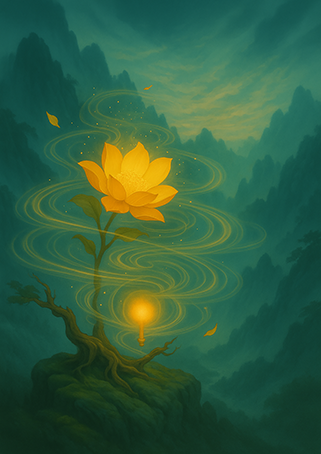Xieyi・The Rootless Tree:100 Verses-Verse 10#425

The poems of “The Rootless Tree” express a fundamental force rooted in harmony with heaven and earth, the cyclical flow of yin and yang, and the infinite potential of existence。
This painting is an expressive “Xieyi” in the tradition of “futu” (spiritual diagrams), passed down for generations in Wudang Mountain, China. It is drawn through a technique where energy flow (xingqi) channels the internal intention into visual form。 In the Taoist world, there exist spiritual and symbolic images called “futu”。
In the Taoist world, there exist spiritual and symbolic images called “futu”。
These are a type of talisman—not merely religious items, but expressive spiritual paintings that act directly on the mind of the viewer。
Since ancient times, many people have placed these Taoist-style “Xieyi” and futu in their homes, studies, or bedrooms, wishing for longevity, health, auspiciousness, and family harmony. Viewing such paintings was not just aesthetic appreciation, but an act of inviting the presence of the Dao into one’s life and tuning the body and mind。
Thus, “Xieyi” is more than artistic expression—it is a medium that bridges the spirit, life, and harmony with the universe。
This kind of artwork is not meant to be seen only with the eyes, but felt with the heart。
It communicates with the Dao, resonates with the qi of nature, and quietly stirs the viewer’s inner self。
Futu and “Xieyi” continue to live on from ancient times to this day as “sacred images that speak to the soul.”
Below, we present the original text of the philosophical poem “The Rootless Tree,” along with a modern Japanese translation and interpretation。
※ The author of “The Rootless Tree,” Zhang Sanfeng (1247–?), is also renowned as the founder of Tai Chi, and it is said that he applied the essence of this work to Tai Chi. As an additional note, we include an interpretation connecting this to the Tai Chi tradition of Wudang Mountain.
The Rootless Tree・Verse 10

▶Original Text
無根樹,花正黃, 不染塵埃透骨香。 一片精神超八卦, 超凡入聖氣芬芳。
▶Modern Translation
A yellow flower blooms on a rootless tree.
Untainted by dust, its fragrance penetrates to the marrow.
Its spirit surpasses even the Eight Trigrams;
Soaring beyond the common, entering the sacred, its qi exudes sweet perfume.
▶Interpretation
1.[無根樹,花正黃] – Yellow stands for centred virtue and nobility.
2.[不染塵埃透骨香] – Unsoiled, its scent reaches deep within the bones.
3.[一片精神超八卦] – A pure spirit transcends the very laws of yin–yang.
4.[超凡入聖氣芬芳] – Rising beyond the ordinary into sagehood, its qi spreads fragrant grace.
▶Interpretation related to Tai Chi
True mastery lies in inner purity and independence from worldly props; completed virtue naturally radiates like an incorruptible scent.
Copyright © MASAKI WAKABAYASHI. All rights reserved.




